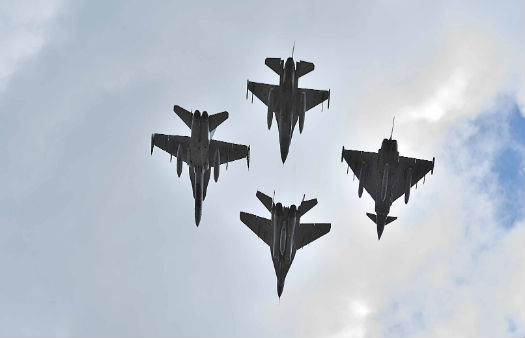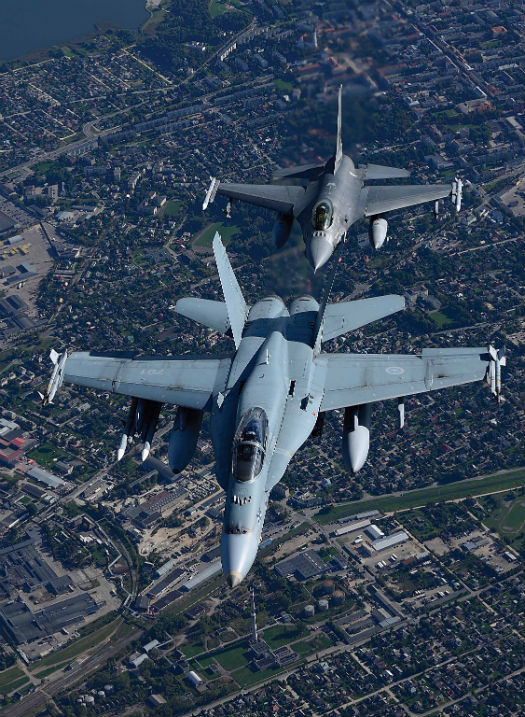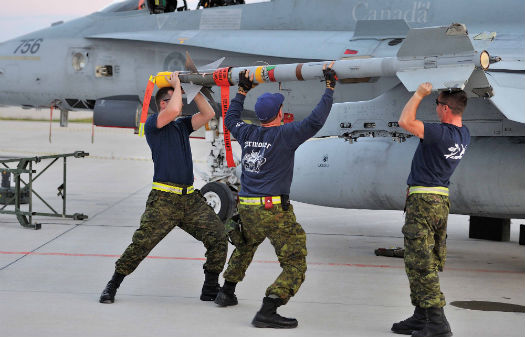A CF-188 Hornet, right, from the Canadian Air Task Force Lithuania and a
Portuguese F16 Fighting Falcon perform manoeuvres over Lithuania on
Sept. 15, 2014, for the NATO Baltic Air PolicingBlock 36 during
Operation Reassurance. Cpl Gabrielle DesRochers Photo
As the Royal Canadian Air Force (RCAF) was readying nine aircraft for a controversial combat mission in the U.S.-led fight against Islamic State (IS) terrorists in Iraq, other RCAF assets have been working well under the political radar as part of a NATO policing mission in the Baltics.
In contrast to Operation Impact——the deployment to a base in Kuwait of six Boeing CF-188 Hornets, an Airbus CC-150 Polaris tanker and two Lockheed CP-140 Aurora intelligence, surveillance and reconnaissance (ISR) platforms against IS forces, supported by 600 personnel—the Baltic mission involves just four Hornets and 135 personnel assigned to Operation Reassurance.
Preserving the integrity of North Atlantic Treaty Organization (NATO) airspace is a collective responsibility. Because Estonia, Latvia and Lithuania lack a full range of air defence assets, other NATO members bolster them to an alliance-wide standard. The Baltic Air Policing (BAP) mission began in 2004, with Allies rotating in “blocks” at four-month intervals, usually one country at a time. However, Russian aggression in the Ukraine earlier this year compelled NATO to enhance that air presence.
Allies in the air: Fighter jets from the Polish Air Force (MiG-29 Fulcrum), the
Royal Air Force (Typhoon FGR4), the Royal Canadian Air Force (CF-188 Hornet),
and the Portuguese Air Force (F-16 Fighting Falcon) conduct a diamond formation
fly-past during the Baltic Air Policing handover ceremony at Šiauliai Air Base,
Lithuania on Sept. 1, 2014, during Operation Reassurance.
Cpl Kenneth Galbraith Photo
Earlier in Op Reassurance, six Hornets with rotating aircrews and some 200 support personnel had been stationed in Ĉampia Turzii, Romania, for “interoperability” training with Romanian Air Force MiG-21 Lancers. Then, the RCAF transitioned at the end of August to Šiauliai, Lithuania, in a continuation of Op Reassurance which will run until year’s end, with personnel rotating in and out.
Canada is the “augmenting” nation in the latest BAP deployment, Block 36, with the Portuguese Air Force, flying General Dynamics F-16 Fighting Falcons out of Ämari Air Base in Estonia, having primary responsibility. The Netherlands, flying F-16s out of Poland, and Germany, flying Eurofighter Typhoons out of Estonia, are also supporting the mission.
Maj John Coffin, deputy commander and chief of staff of Air Task Force Lithuania, told Skies that the decision to reduce the RCAF presence to four aircraft from the six deployed in Romania was based on discussions with the other participants. “It was determined that we would able to do the policing with four….and that lets us get other assets back home for further training or other operations that may come up.”
Canada is the “augmenting” nation in the latest Baltic Air Policing deployment.
The Portuguese Air Force has primary responsibility, flying F-16 Fighting
Falcons (one is shown here behind a Canadian CF-188 Hornet).
Cpl Gabrielle DesRochers Photo
Manfred Reudenbach, spokesman for air command headquarters at Ramstein Air Base in Germany, confirmed to Skies that when Poland and Canada withdraw their air forces at the end of the year, Italy will deploy its Typhoons to Šiauliai as lead country for Block 37, while Spain, also flying Typhoons, has “indicated” that it will take over the BAP “augmentation” role out of Ämari.
Unlike the Kuwait deployment—which was put to a vote in Parliament in early October and was approved by a vote of 157 to 134 as the government used its majority to ensure a favourable outcome—there has been no criticism of the Baltic mission, which the government said in July was simply part of Canada’s “continued commitment to . . . NATO collective defence.”
The Baltic airspace comprises six “declared identification” zones. If unknown aircraft show on radar, a visual intercept is launched and, if necessary, intruders are shadowed until they leave the zone. As of mid-October, RCAF Hornets had been scrambled on intercepts off the Lithuanian coast. Each intruder was a Russian Federation Air Force Antonov AN-26 Curl, a twin-engine turboprop transport last produced in 1985. Unarmed and not considered a threat to NATO forces, they were nevertheless shown the door.
Armament specialists attach a wing weapon to a CF-188 Hornet at Šiauliai
Air Base, Lithuania. Cpl Kenneth Galbraith Photo
Coffin, an air combat systems officer on the CC-130 Hercules from 8 Wing in Trenton, Ont., said the Canadian Hornets have been flying just about every day. “We do some training with the other nations in the local area,” he said. “Just bringing them all together in a NATO context with NATO procedures is great.”
A “typical” day begins with a morning briefing on weather, intelligence and any operational changes. “Our pilots do a lot of coordination with the others with regard to the type of training they might do that day,” he said. “Then they’ll go flying for an hour to an hour and a half, and do some training before recovering back here—and then they’ll try to do that again in the afternoon.”
He said there is “never a boring day here” on the BAP calendar. Morale is high. “I like to use the analogy of a marathon runner who trains all the time and then he doesn’t get the opportunity to run the marathon,” he said. “So you’re right: having those guys do all the necessary training back home and then come on a deployed operation and have the opportunity to exercise that training? They’re ecstatic.”
LCol David Pletz, commander of Canadian Air Task Force Lithuania, inspects a
CF-188 Hornet before flight. Cpl Gabrielle DesRochers Photo
Nor have there been any issues with the Hornets from 425 Tactical Fighter Squadron in Bagotville, Que., despite the fact that they have been the RCAF’s line fighter since 1982 and are due for retirement in 2017.
“We have been able to meet 100 per cent of our Baltic Air Policing mandate,” said Coffin. “Our maintenance crews do a fantastic job of keeping the aircraft going.”
Having never finished an engineering degree (“probably a service to aviation,” Ken says), Ken Pole has had a lifelong passion for things with wings. The longest-serving continuous member of the Parliamentary Press Gallery in Ottawa, Ont., he has written about aerospace in all its aspects for more than 30 years. When not writing, he’s an avid sailor, diver and photographer.









